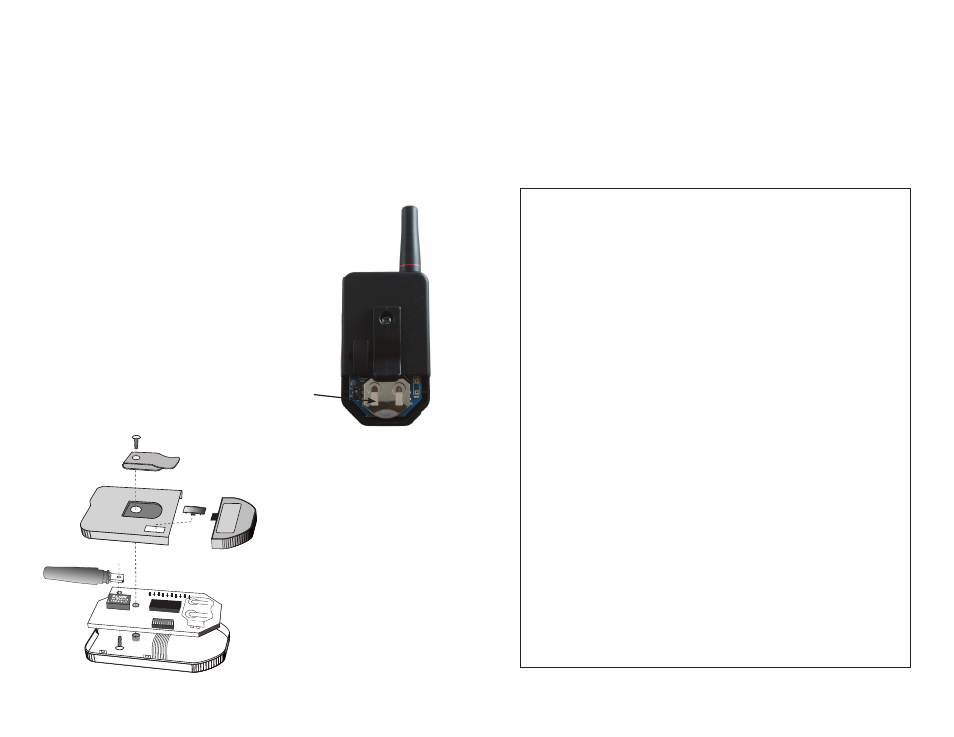Connection considerations, Battery replacement, Assembly diagram – Linx Technologies CMD-HHLR-xxx User Manual
Page 6: Labeling / instruction requirements

– –
– –
6
7
Connection Considerations
It is important to understand that only one transmitter at a time can be
activated within a reception area. While the transmitted signal consists
of encoded digital data, only one carrier of any particular frequency can
occupy airspace without contention at any given time. If two transmitters
are activated in the same area at the same time, then the signals will
interfere with each other and the decoder will not see a valid transmission,
so it will not take any action.
Battery Replacement
The remote unit utilizes a standard CR2032
lithium button cell. To replace the battery,
remove the access cover by pressing down
firmly on the label area and sliding it off. Once
the unit is open, remove the battery by sliding
it from beneath the holder. Replace it with
the same type of battery while observing the
polarity shown in Figure 8.
There may be the risk of explosion if the battery
is replaced by the wrong type.
Assembly Diagram
+
Figure 8: Battery Access
Figure 9: CMD-HHLR-***-MD Assembly
Battery
access
Labeling / Instruction Requirements
The transmitter has been pre-certified for FCC Part 15 and Industry Canada
license-exempt RSS standards for an intentional radiator. The 433.92MHz
version has also been tested for CE compliance for use in the European
Union. The 315MHz and 418MHz versions are not legal for use in Europe.
It has already been labeled in accordance with FCC, Industry Canada
and CE regulations. No further labeling of the unit is needed; however,
it is necessary to include the following statement in the end product’s
instruction manual or insert card. EU does not require a statement.
INSTRUCTION TO THE USER
This device complies with Part 15 of the FCC Rules and Industry Canada licence-
exempt RSS standard(s). Operation of this device is subject to the following two
conditions:
1. This device may not cause harmful interference, and
2. This device must accept any interference received, including interference
that may cause undesired operation.
This equipment has been tested and found to comply with the limits for a Class B
digital device, pursuant to Part 15 of the FCC Rules. These limits are designed to
provide reasonable protection against harmful interference in a residential installation.
This equipment generates, uses and can radiate radio frequency energy and, if not
installed and used in accordance with the instructions, may cause harmful interference
to radio communications. However, there is no guarantee that interference will not
occur in a particular installation. If this equipment does cause harmful interference to
radio or television reception, which can be determined by turning the equipment off
and on, the user is encouraged to try to correct the interference by one or more of the
following measures:
• Reorient or relocate the receiving antenna.
• Increase the separation between the equipment and receiver.
• Connect the equipment into an outlet on a circuit different from that to which the
receiver is connected.
• Consult the dealer or an experienced radio / TV technician for help.
The user is cautioned that changes and modifications made to the equipment without
the approval of manufacturer could void the user’s authority to operate this equipment.
Le présent appareil est conforme aux CNR d'Industrie Canada applicables aux
appareils radioexempts de licence. L'exploitation est autorisée aux deux conditions
suivantes : (1) l'appareil ne doit pas produire de brouillage, et (2) l'utilisateur de
l'appareil doit accepter tout brouillage radioélectrique subi, même si le brouillage est
susceptible d'en compromettre le fonctionnement.